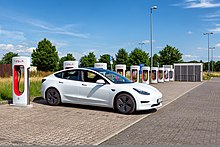Adoption of electric cars is taking place faster and faster. In Norway, new car sales are mostly battery electric vehicles (BEV) or plug-in hybrid electric vehicles (PHEV). In February 2021 they reached 86.1% market share. So, it is time to talk about the elephant in the room – range.
BMW contends that 500km (300 miles) is enough range for an electric car. But Lucid, Tesla, Fisker and Kia are all pushing higher ranges, so what is the real story? I have owned a Tesla Model S 85 D since 2016 which has a range of about 425km (260 miles). The first thing to understand about range is it is an estimate. While our car is rated to 425km we never get that. I suppose if we had a cloudy day that was 22 C(72 F) we might get away without any climate control and could therefore reach the promised range – if the road is level. There are too many factors that go into battery consumption that it is impossible to really predict real world range. Some trips we have gotten more range, but that is because we went downhill for most of the trip (returning from the alps), but most of the time we get less.
The good news is the estimate is based on the same test procedure for all electric cars. The bad news is not all companies treat it equally. Porsche tends to underestimate the range (sounds good to me), but Tesla tends to overestimate their range (not as good). So, from a metric standpoint range is hard to get a hold of. The perception that range is important makes range everything. It is the main metric by which electric cars are measured. There is something else that is more important which I will get to in a bit and that is charging rate.
Let’s get back to the point BMW has made that 500km is enough. Most of the time you use your electric car from home. You drive all day and come home and charge. It is difficult to imagine using more than 500km in a day. It is possible to be sure, but for most errands or sightseeing you will not do it. When you get home, you plug your car in and it is ready for the next day. That has been the reality for us since 2016. Every day we plug in and every day we have a fully charged car in the morning. So, in this case range means nothing. We have enough range for our daily usage and that is all that matters. And we never have to go to the filling station.
But, what about taking trips? Surely range can be a problem on trips. Well, in a word, no. It isn’t a problem. The reality is we can drive 4 hours before we need to stop and charge. The reality is I need to stop after 4 hours, so we are in sync on that. Typically, with a fossil fuel car, you will need about 5 minutes to fuel up. Then you might need a personal break like I do. The combined time for the break will be about 15-20 minutes. It is pretty hard to get shorter than that. With an electric car when you stop you plug in and leave it. Hit the restrooms, grab a bottle of water, come back to your car in 20 minutes and, with today’s charging rates, you should be ready for another 4 hours of driving. Once you get to your hotel you can plug in and overnight your car is charged and ready to go, just like you.
The key to this is charging rate. Our older Tesla doesn’t charge that fast. The reality for us is it takes about 40 minutes, but we plan our lunch at the break time and at the end of the meal we are charged up and ready to go. Most of the time it doesn’t have any impact on our trip.
Our range is less than what BMW thinks is optimal and frankly, I agree with them. An extra hour of driving and faster charging would make trips easier. Does anyone need 1000km (620 miles) of range? Maybe truckers do, but for most people it is overkill. To obtain that range batteries need to have larger capacity and with current chemistry that means bigger packs. Bigger packs mean more cost and, more importantly, more weight. Weight is the enemy of range, so the more batteries you add the more batteries you need to get the range you want.
Range is everything because it is one of the main metrics buyers can use when buying an electric car. But, ultimately it means nothing because as long as there is enough (which I think is 500km) then it doesn’t matter. It means nothing, but charging rate means a lot more.
Charging rate is measured in kW (kilowatts) and the higher the number the faster the car charges. There is a caveat to this and that is the car will only obtain the fastest charging rate when the battery is empty. On trips it is important to remember this and fight the urge to keep your battery charged. Roll into a charging station with the battery as low as you can stand, and it will charge at the fastest rate possible to allow you to make the shortest stop.
When buying an electric car check the range to be sure it is enough then look at the more important number – the charging rate.
